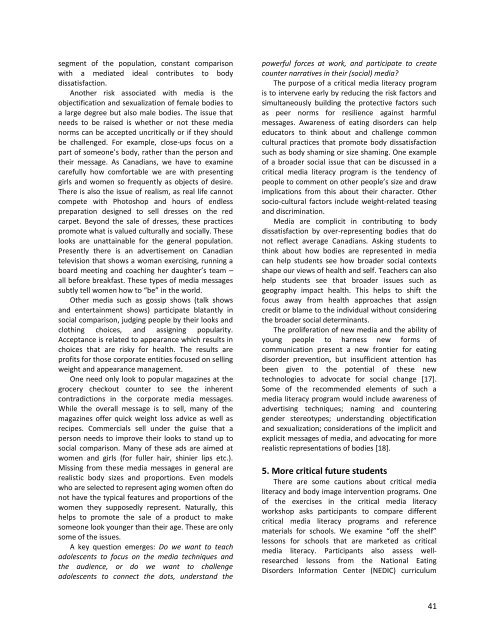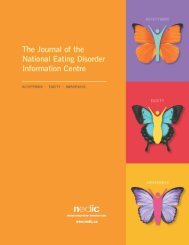NEDIC Conference Journal 2018
You also want an ePaper? Increase the reach of your titles
YUMPU automatically turns print PDFs into web optimized ePapers that Google loves.
segment of the population, constant comparison<br />
with a mediated ideal contributes to body<br />
dissatisfaction.<br />
Another risk associated with media is the<br />
objectification and sexualization of female bodies to<br />
a large degree but also male bodies. The issue that<br />
needs to be raised is whether or not these media<br />
norms can be accepted uncritically or if they should<br />
be challenged. For example, close-ups focus on a<br />
part of someone’s body, rather than the person and<br />
their message. As Canadians, we have to examine<br />
carefully how comfortable we are with presenting<br />
girls and women so frequently as objects of desire.<br />
There is also the issue of realism, as real life cannot<br />
compete with Photoshop and hours of endless<br />
preparation designed to sell dresses on the red<br />
carpet. Beyond the sale of dresses, these practices<br />
promote what is valued culturally and socially. These<br />
looks are unattainable for the general population.<br />
Presently there is an advertisement on Canadian<br />
television that shows a woman exercising, running a<br />
board meeting and coaching her daughter’s team –<br />
all before breakfast. These types of media messages<br />
subtly tell women how to “be” in the world.<br />
Other media such as gossip shows (talk shows<br />
and entertainment shows) participate blatantly in<br />
social comparison, judging people by their looks and<br />
clothing choices, and assigning popularity.<br />
Acceptance is related to appearance which results in<br />
choices that are risky for health. The results are<br />
profits for those corporate entities focused on selling<br />
weight and appearance management.<br />
One need only look to popular magazines at the<br />
grocery checkout counter to see the inherent<br />
contradictions in the corporate media messages.<br />
While the overall message is to sell, many of the<br />
magazines offer quick weight loss advice as well as<br />
recipes. Commercials sell under the guise that a<br />
person needs to improve their looks to stand up to<br />
social comparison. Many of these ads are aimed at<br />
women and girls (for fuller hair, shinier lips etc.).<br />
Missing from these media messages in general are<br />
realistic body sizes and proportions. Even models<br />
who are selected to represent aging women often do<br />
not have the typical features and proportions of the<br />
women they supposedly represent. Naturally, this<br />
helps to promote the sale of a product to make<br />
someone look younger than their age. These are only<br />
some of the issues.<br />
A key question emerges: Do we want to teach<br />
adolescents to focus on the media techniques and<br />
the audience, or do we want to challenge<br />
adolescents to connect the dots, understand the<br />
powerful forces at work, and participate to create<br />
counter narratives in their (social) media?<br />
The purpose of a critical media literacy program<br />
is to intervene early by reducing the risk factors and<br />
simultaneously building the protective factors such<br />
as peer norms for resilience against harmful<br />
messages. Awareness of eating disorders can help<br />
educators to think about and challenge common<br />
cultural practices that promote body dissatisfaction<br />
such as body shaming or size shaming. One example<br />
of a broader social issue that can be discussed in a<br />
critical media literacy program is the tendency of<br />
people to comment on other people’s size and draw<br />
implications from this about their character. Other<br />
socio-cultural factors include weight-related teasing<br />
and discrimination.<br />
Media are complicit in contributing to body<br />
dissatisfaction by over-representing bodies that do<br />
not reflect average Canadians. Asking students to<br />
think about how bodies are represented in media<br />
can help students see how broader social contexts<br />
shape our views of health and self. Teachers can also<br />
help students see that broader issues such as<br />
geography impact health. This helps to shift the<br />
focus away from health approaches that assign<br />
credit or blame to the individual without considering<br />
the broader social determinants.<br />
The proliferation of new media and the ability of<br />
young people to harness new forms of<br />
communication present a new frontier for eating<br />
disorder prevention, but insufficient attention has<br />
been given to the potential of these new<br />
technologies to advocate for social change [17].<br />
Some of the recommended elements of such a<br />
media literacy program would include awareness of<br />
advertising techniques; naming and countering<br />
gender stereotypes; understanding objectification<br />
and sexualization; considerations of the implicit and<br />
explicit messages of media, and advocating for more<br />
realistic representations of bodies [18].<br />
5. More critical future students<br />
There are some cautions about critical media<br />
literacy and body image intervention programs. One<br />
of the exercises in the critical media literacy<br />
workshop asks participants to compare different<br />
critical media literacy programs and reference<br />
materials for schools. We examine “off the shelf”<br />
lessons for schools that are marketed as critical<br />
media literacy. Participants also assess wellresearched<br />
lessons from the National Eating<br />
Disorders Information Center (<strong>NEDIC</strong>) curriculum<br />
41




